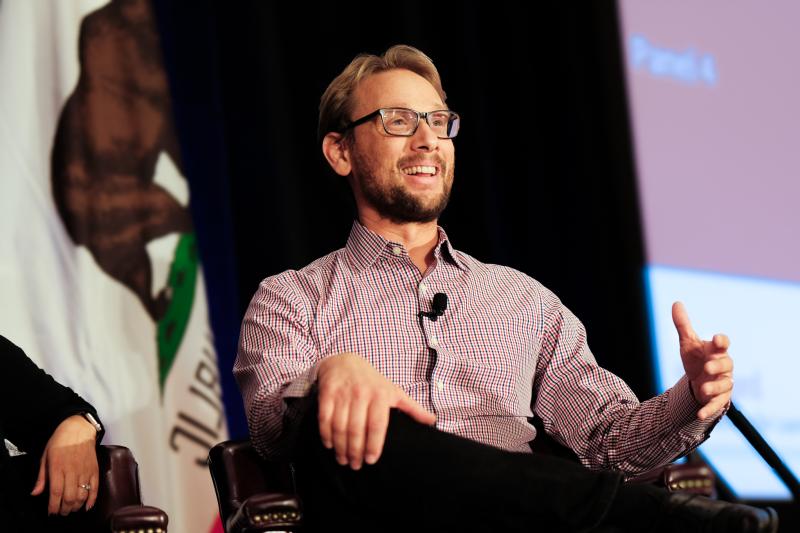
Online learning: Somewhere between avalanche and revolution
The Education Writers Association celebrated its 66th national seminar at Stanford last week, and among the top topics of conversation was online learning. Its prominence was made clear by the three-day meeting's title: "Creativity counts: Innovation in education and the media."
On May 2, panel convened to discuss "What online learning means for college classrooms,” which was moderated by Claudia Dreifus, the producer of the weekly feature “Conversation with…” of the Science Section of the New York Times. She started things off by referring to a recently co-written study by one of the three panelists, Sir Michael Barber, chief education strategist at Pearson, which calls itself the world's leading education company.
The study is "An Avalanche is Coming: Higher Education and the Revolution Ahead." Avalanches are wont to set things off, as did her question: Is this really an avalanche or can we control the course of new online technologies?
"If you look at a snow-covered hillside it looks solid but under the surface things are happening, and you don't know when they'll happen,” said Barber, who was a top education advisor to Prime Minister Tony Blair. “That's what we've tried to bring out.... The key thing is that you don't stand still in the face of an avalanche."
Nor is it easy to distinguish all its various parts, and Stanford's vice provost for online learning, John Mitchell, was insistent that the opportunities and dangers of online learning are a work in progress.
First off, he pointed out, Stanford has been engaging in distance learning since the 1950s. The concept is not new; what's new are the technologies and possibilities, most of which we can barely envision today. Second, he said massive open online courses, or MOOCs, are just one part of the story, or stories. Online learning involves on-campus classes, classes for people around the world, social networking with educational ends and a seedbed of data that can help teachers become better at what they do.
"All these tools are really powerful," Mitchell told the audience of about 200 journalists and other education communicators. "Right now we're trying to understand new ways of using them, new learning models. We're really at the beginning of something that will take years to develop, but we've become more efficient, and we'll learn what works better."
The Education Writers Association’s national seminar was hosted by the Stanford Graduate School of Education, the Stanford Center for Opportunity Policy in Education and the American Educational Research Association. In addition to Mitchell, a dozen Stanford scholars were among the featured speakers at the conference, including presentations on achievement gaps, why high-achieving but low-income kids don't apply to selective colleges, charter schools and stereotype threat.
The third member of the panel on May 2 was Mark Smith, senior policy analyst at the National Education Association, the largest professional employee organization in the United States, comprising instructors from pre-school to university level. Not surprisingly, Smith stressed, along with the potential of technology, the essential role of teachers and professors, many of whom are represented by his union.
His organization is grappling with the implications, he said. "We believe online learning has the potential for improving things, but we also have issues we want to be certain are addressed. It's important for us that we address equity situations. There's a vast disparity among students, and if we don't address that adequately, we could be increasing achievement gaps instead of closing them."
Agreeing with Mitchell that distance learning in one form or another has been with us for a long time, Smith suggested it began "when Plato began writing down what Socrates said. And today, you can learn philosophy without being with them in Athens."
"Done right," he said, "it won't be an avalanche." But, he said, pointing to how much education has always transformed itself, it might be a revolution — a metaphor no more reassuring, or easy to grasp, for some of those present.
Barber, who has held education posts in the U.K. government, pointed out that revolutions by definition cannot be controlled. "None of us know how this is going to go," he said. One intriguing option he floated was that universities could be "unbundled" into their various functions, so they would not necessarily compete as institutions but rather at the level of each of their unbundled services.
Questions from education writers in the audience, representing wire services, newspapers, radio stations and universities, focused on the mechanics of online learning as well as on the specter of elite institutions leaving the rest behind.
One questioner asked about online cheating, to which Mitchell, whose field of expertise is, precisely, computer security, admitted there's no silver bullet, though machine learning and techniques such as keystroke timing can certainly help in authenticating who is actually taking the class.
Mitchell also responded to questions suggesting that online learning, while reaching people who otherwise would never have the opportunity to learn certain subjects at a high level, might also broaden the gap, as Smith mentioned. Mitchell pointed out that Stanford's platform for online learning is free and open-source and the university is happy to share it — and not just with top-level schools. As for online classes becoming vehicles for famous professors to become even more famous, he said, textbooks followed exactly that path.
Speaking of textbooks, Barber said Pearson, which develops materials, tools, technology and analyses for a wide range of education problems, is putting its existing textbooks online and, moving forward, creating e-books. That trend is true of all education publishers, he said, at this "very early stage of the revolution."
R. F. MacKay is the communications manager in the Office of the Vice Provost for Online Learning.



